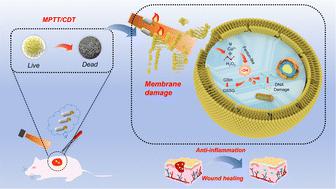当前位置:
X-MOL 学术
›
J. Mater. Chem. B
›
论文详情
Our official English website, www.x-mol.net, welcomes your feedback! (Note: you will need to create a separate account there.)
Copper peroxide nanodot-decorated gold nanostar/silica nanorod Janus nanostructure with NIR-II photothermal and acid-triggered hydroxyl radical generation properties for the effective treatment of wound infections
Journal of Materials Chemistry B ( IF 7 ) Pub Date : 2024-04-18 , DOI: 10.1039/d4tb00536h Yan Lu 1 , Rui Xu 1 , Wei Liu 1 , Xiling Song 1 , Wanqin Cai 1 , Yuan Fang 1 , Wei Xue 1 , Siming Yu 1
Journal of Materials Chemistry B ( IF 7 ) Pub Date : 2024-04-18 , DOI: 10.1039/d4tb00536h Yan Lu 1 , Rui Xu 1 , Wei Liu 1 , Xiling Song 1 , Wanqin Cai 1 , Yuan Fang 1 , Wei Xue 1 , Siming Yu 1
Affiliation

|
Recently, bacterial infections have become a global crisis, greatly threatening the health of human beings. The development of a non-antibiotic biomaterial is recognized as an alternative way for the effective treatment of bacterial infections. In the present work, a multifunctional copper peroxide (CP) nanodot-decorated gold nanostar (GNS)/silica nanorod (SiNR) Janus nanostructure (GNS@CP/SiNR) with excellent antibacterial activity was reported. Due to the formation of the Janus nanostructure, GNS@CP/SiNR displayed strong plasmonic resonance absorbance in the near infrared (NIR)-II region that enabled the nanosystem to achieve mild photothermal therapy (MPTT). In acidic conditions, CP decorated on GNS@CP/SiNR dissociated rapidly by releasing Cu2+ and H2O2, which subsequently transformed to ˙OH via the Fenton-like reaction for chemodynamic therapy (CDT). As a result, GNS@CP/SiNR could effectively inhibit both Gram-negative Escherichia coli (E. coli) and Gram-positive Staphylococcus aureus (S. aureus), and eradicate the associated bacterial biofilms by exerting the synergistic MPTT/CDT antibacterial effect. Moreover, GNS@CP/SiNR was also demonstrated to be effective in treating wound infections, as verified on the S. aureus-infected full thickness excision wound rat model. Our mechanism study revealed that the synergistic MPTT/CDT effect of GNS@CP/SiNR firstly caused bacterial membrane damage, followed by boosting intracellular ROS via the severe oxidative stress effect, which subsequently caused the depletion of intracellular GSH and DNA damage, finally leading to the death of bacteria.
中文翻译:

过氧化铜纳米点装饰的金纳米星/二氧化硅纳米棒Janus纳米结构具有NIR-II光热和酸触发羟基自由基生成特性,可有效治疗伤口感染
近年来,细菌感染已成为全球性危机,极大威胁人类健康。非抗生素生物材料的开发被认为是有效治疗细菌感染的替代方法。在本工作中,报道了一种具有优异抗菌活性的多功能过氧化铜(CP)纳米点装饰的金纳米星(GNS)/二氧化硅纳米棒(SiNR)Janus纳米结构(GNS@CP/SiNR)。由于Janus纳米结构的形成,GNS@CP/SiNR在近红外(NIR)-II区域表现出很强的等离激元共振吸收,使纳米系统能够实现温和的光热治疗(MPTT)。在酸性条件下,GNS@CP/SiNR上的CP装饰迅速解离,释放出Cu 2+和H 2 O 2,随后通过类芬顿反应转化为˙OH,用于化学动力学治疗(CDT)。结果,GNS@CP/SiNR能够有效抑制革兰氏阴性大肠杆菌(E.coli)和革兰氏阳性金黄色葡萄球菌(S.aureus),并通过发挥协同MPTT/CDT抗菌作用根除相关细菌生物膜。 。此外,GNS@CP/SiNR 也被证明可有效治疗伤口感染,这在金黄色葡萄球菌感染的全层切除伤口大鼠模型上得到了验证。我们的机制研究表明,GNS@CP/SiNR 的协同 MPTT/CDT 效应首先引起细菌膜损伤,然后通过严重的氧化应激作用增加细胞内 ROS,进而导致细胞内 GSH 消耗和 DNA 损伤,最终导致细菌的死亡。
更新日期:2024-04-18
中文翻译:

过氧化铜纳米点装饰的金纳米星/二氧化硅纳米棒Janus纳米结构具有NIR-II光热和酸触发羟基自由基生成特性,可有效治疗伤口感染
近年来,细菌感染已成为全球性危机,极大威胁人类健康。非抗生素生物材料的开发被认为是有效治疗细菌感染的替代方法。在本工作中,报道了一种具有优异抗菌活性的多功能过氧化铜(CP)纳米点装饰的金纳米星(GNS)/二氧化硅纳米棒(SiNR)Janus纳米结构(GNS@CP/SiNR)。由于Janus纳米结构的形成,GNS@CP/SiNR在近红外(NIR)-II区域表现出很强的等离激元共振吸收,使纳米系统能够实现温和的光热治疗(MPTT)。在酸性条件下,GNS@CP/SiNR上的CP装饰迅速解离,释放出Cu 2+和H 2 O 2,随后通过类芬顿反应转化为˙OH,用于化学动力学治疗(CDT)。结果,GNS@CP/SiNR能够有效抑制革兰氏阴性大肠杆菌(E.coli)和革兰氏阳性金黄色葡萄球菌(S.aureus),并通过发挥协同MPTT/CDT抗菌作用根除相关细菌生物膜。 。此外,GNS@CP/SiNR 也被证明可有效治疗伤口感染,这在金黄色葡萄球菌感染的全层切除伤口大鼠模型上得到了验证。我们的机制研究表明,GNS@CP/SiNR 的协同 MPTT/CDT 效应首先引起细菌膜损伤,然后通过严重的氧化应激作用增加细胞内 ROS,进而导致细胞内 GSH 消耗和 DNA 损伤,最终导致细菌的死亡。






























 京公网安备 11010802027423号
京公网安备 11010802027423号